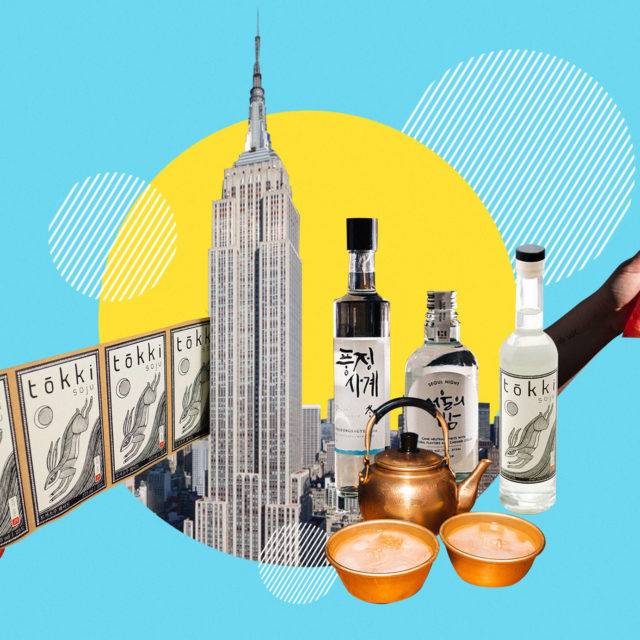In the last decade, a slate of exceptional and new-school Korean restaurants introduced New York diners to the finer points of Korean cooking. These restaurants span styles, Michelin stars, and neighborhoods, but for a long time they had one thing in common: their beverage programs lacked high-quality Korean booze, or sool.
“Sool” is a Korean word representing all the country’s alcoholic beverages. It encompasses thousands of forms, from soju to makgeolli to fruit wines. In an effort to introduce American drinkers and diners to quality sool, master sommelier Kyungmoon Kim launched KMS Imports in January. He’s working with seven craft sool brewers and carries a tight nine selections of soju, chungju, makgeolli (pronounced mahk-ul-lee), and plum wine. “With sool, it’s time for people to understand the story and really the true artisanship behind it,” he says.
From importers like Kim, to Korean and Korean-American chefs, bartenders, sommeliers, brewers, and entrepreneurs, a younger generation of drinks professionals is making sure New Yorkers have sool to match the caliber of the city’s Korean cooking.
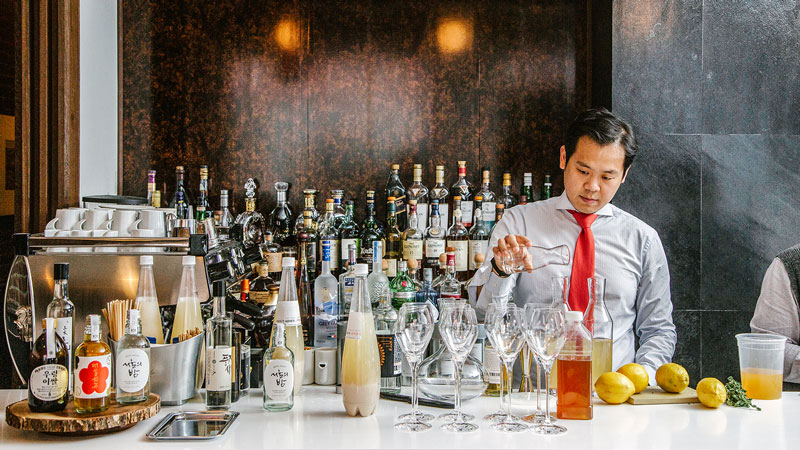
How the Korean War Changed Sool
Much of the artisanship behind sool was lost or forgotten in the aftermath of the Korean War. In 1965, due to rice shortages, the Korean government banned the use of rice in alcohol production, which forced many smaller producers to close and led to mass consolidation of the industry. “At the time, it made sense. People barely had money to put food to the table. They really just needed cheap alcohol to get through the day,” says Kim. “But the rich heritage of rice brewing and soju-making sort of fell apart.”
A legacy of that period is inexpensive green bottle soju, one of the most consumed and beloved alcoholic beverages on the planet. Even though the rice ban was lifted in 1999, industrial soju is still mostly made with sweet potatoes, barley, tapioca, and other inexpensive commodity starches. It’s a diluted neutral spirit with added preservatives and artificial sweeteners and, sometimes, flavors.
“It’s a chemical Kool-Aid,” says James Kumm, co-owner of Yobo, a New York State craft soju brand. “There are two words people throw around with soju: traditional and authentic. Green bottle soju is authentic, but it’s not traditional. It’s a very modern product.”
Some old-school sool-making practices survived, though, especially in villages and with home brewers. However, well-made jeontongju, or traditional sool, was a rarity in Korea and even more so in America, according to Alice Jun, owner of Hana Makgeolli in Greenpoint, Brooklyn.
“Quality sool wasn’t widely available in Korea for a long time, especially in Seoul,” says Jun. “It’s a funny thing. Obviously, people are learning about sool in America, but it’s happening in Korea, too.”
Traditional and Modern Products Enter the Market
Alice Jun is a devotee of jeontongju. Growing up, her dad homebrewed makgeolli, a cloudy, naturally fermented, and just-fizzy rice-based brew. “I understood makgeolli to be tart, dry, complex, funky, and nutty with punch-you-in-the-face alcohol,” she says.
Instead, all she could find on the market was industrial makgeolli, jacked up with aspartame, citric acid, and artificial flavors.
“With Hana, I thought, ‘Wouldn’t it be cool if there was makgeolli that could be served with elevated Korean food, something that would complement the cuisine and wouldn’t overwhelm diners’ palates?’” says Jun.
After three years of experimenting and brewing, Jun will officially launch Hana Makgeolli in early September with bottles that will clock in at 16 percent ABV and remain unpasteurized to fully convey the nuances of fermentation.
Brandon Hill has a similar fervor for jeontongju, though he came to it in a much more roundabout fashion. Hill studied fermentation and distillation in Korea in 2011, and when he returned to the States and a job distilling at Van Brunt Stillhouse, he had no intention of making soju. But eventually, a friend at Insa, a Korean restaurant and karaoke bar in Brooklyn, asked Hill to make their house soju. Diners and the Korean restaurant community were enamored of Hill’s soju, leading him to develop his own brand, Tokki, in 2018.
“Most people who know soju have the connotation that it’s a spirit you drink to get trashed at a karaoke room. The traditional versions were never exported,” says Hill, who moved to Seoul this year to expand Tokki’s operations and tap into an even larger Korean market.
For their respective products, Hill and Jun both rely on a combination of modern brewing technology and ancient techniques to coax alcohol from steamed rice, water, and nuruk, a steamed wheat cake that develops mold, yeast, and bacteria strains that activate fermentation and allow rice starch to be converted to sugar and then alcohol.
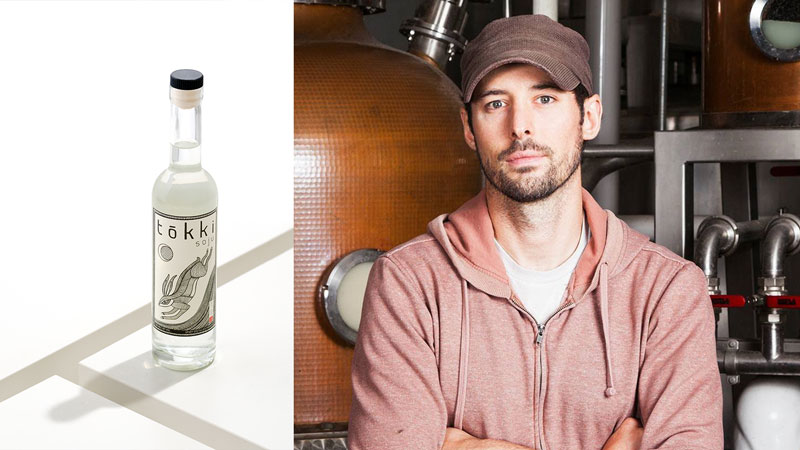
Old-School Rice Brewing: A Primer
In the United States, soju is by far the most well-known product derived from nuruk-based rice brewing. But the full range of traditional Korean rice alcohol starts with wonju.
Wonju is the original unfiltered mash of unpolished rice, nuruk, and water. Wonju’s maximum ABV ranges from 19 to 23 percent, based on a brewer’s fermentation methods, and it’s cloudy with sediment. Wonju naturally settles and forms a clear layer on top that’s called chungju or yakyu. (Yangchon chungju is one of the few examples on the market.) The leftover sediment layer is called takju.
“Royals drank the clear chungju and discarded all the sediment, but the peasants took the takju home because it still contained alcohol. They would pour in water for volume and to lower the alcohol,” says Kim.
Diluted tajku is makgeolli. There’s a bit of nuance to the category, though. Some brewers, including Jun, dilute wonju to make their makgeolli, choosing to keep the character of the chungju as part of the final product. And in Korea, any diluted brew with more than 10 percent alcohol is considered takju; below 10 percent, it’s makgeolli.
Depending on the brewery, rice-based soju can be distilled from wonju, chungju, or takju, and the distillate reaches 40 to 45 percent alcohol.
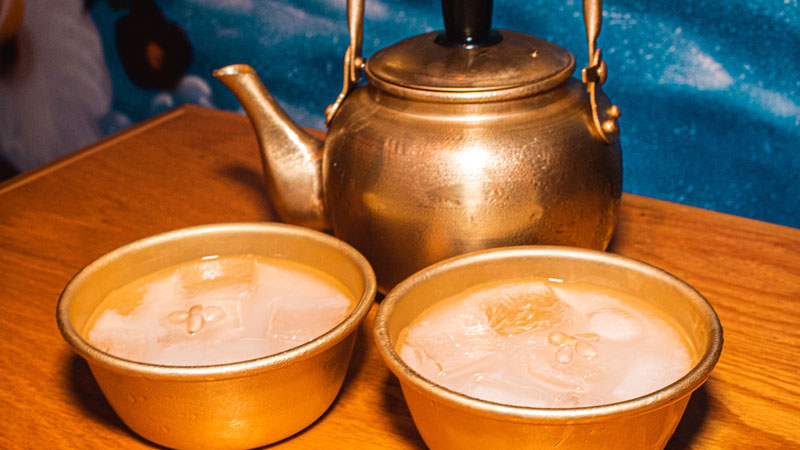
Soju, an Expansive Category
Now, only a fraction of soju is brewed from rice and with nuruk, but soju made from other grains or sugar sources aren’t necessarily poor quality. KMS Imports counts among its selections Golden Barley Soju, which has notes of cedar and honey; and Seoul Night, a soju distilled from plum wine and laced with juniper.
Yobo, owned by James Kumm and his wife Carolyn Kim, is distilled from Catawba grapes grown in of New York State. Distillation sloughs off some of the grape’s rougher, musky characteristics while “retaining a lot of grape aromatics,” says Carolyn.
Also based in upstate New York, West 32 (named for NYC’s West 32nd Street in Koreatown) produces corn-based soju and was an early proponent of barrel aging, a technique that wasn’t adopted in Korea until the mid-aughts.
There’s still a place for green bottle soju, too, especially in cocktails. Katie Rue opened the Lower East Side’s Reception Bar in 2018, and says her goal “is to showcase and take space for Korean-American-ness.” She stocks bottles from KMS Imports but still uses Jinro 24 for all her infusions.
Reception Bar’s menu, which has been thinned for take-out only service, includes five infused sojus (matcha, osmanthus, Korean green pepper, white lotus, and artemisia) and six cocktails that all highlight soju and Korean ingredients.
Cocktail consultant and “basic Queens girl” Haera Shin incorporates peach-flavored soju into East Village restaurant Nowon’s brunch-tastic sangria riff, the “GZB.”
“We used to get made fun of for drinking flavored soju, but we’re taking it back,” says Shin, who also recently developed a recipe for Makku-chata, a sharable horchata riff made with makgeolli, sesame-washed soju, and pine nuts.
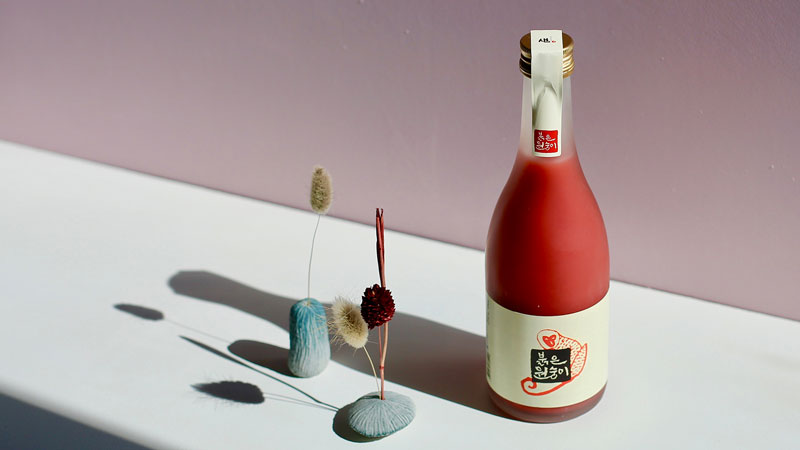
Moves in Makgeolli
Like soju, most makgeolli in the States is produced industrially from a variety of starches and fermented with koji instead of nuruk. Jun says she loves all makgeolli, even the sweetened commercial stuff, but she’s excited about the growing number of quality makgeolli available in America.
Kim imports blush-pink Red Monkey Makgeolli, whose producer, Sulseam, inoculates rice with a type of red yeast that imparts its characteristic color to the drink, along with notes of red fruit and rose petals.
In 2019, Carol Pak launched Makku, a line of canned makgeolli. Growing up in Queens, Pak remembers sneaking makgeolli out of friends’ parents’ stashes, but she didn’t pay much attention to the category until she worked as an entrepreneur in residence for Anheuser-Busch InBev. When she visited a craft makgeolli bar in Seoul, she thought American drinkers, with their penchant for hazy IPAs and sour ales, would go for makgeolli.
“Makgeolli is Korea’s drink,” says Pak, who likens it to nigori sake. “There’s no substitute in America.”
Makku’s and Hana Makgeolli’s recent arrivals prove that — though the sool scene is a small one — there’s ample room in the United States for new sool producers and styles, from spirits like soju, to fruit wines and herbal liqueurs. “I think it has to be an all-around approach, [an] attack from all sides,” says Jun. “The main goal is to establish Korean alcohol as its own category.”
